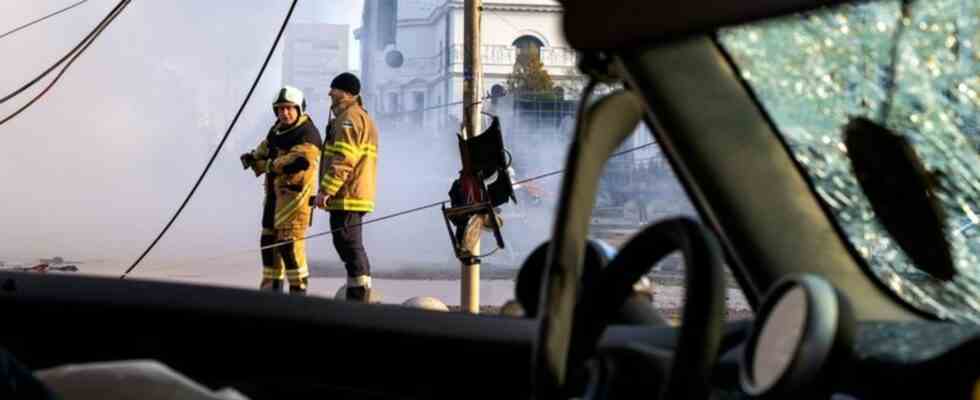war against Ukraine
What is behind the new Russian missile attacks
Firefighters are on duty at an impact site in central Kyiv. photo
© Roman Hrytsyna/AP/dpa
With attacks on energy companies and other important infrastructure in Ukraine, Russia is causing international horror. Can this approach make up for the recent setbacks?
For the first time in months, Russia is again massively attacking targets throughout Ukraine. Attacks on cities like Kyiv with cruise missiles and drones raise concerns that Vladimir Putin’s brutal war of aggression is far from over. Or are there other scenarios? Questions and answers at a glance:
What does Russia want to achieve with the attacks?
At least for the moment, the Russian leadership has turned the momentum in public perception. The rocket attacks have led to massive problems in Ukraine’s energy supply. In some regions the power went out completely, showing Ukraine’s vulnerability. Moscow’s hardliners in particular have been calling for such blows for a long time. They hope that this will have both a deterrent effect and a real military weakening of Ukraine, because communications will also be affected.
In view of the approaching winter, the Kremlin may also be hoping to regain a position of strength at the negotiating table with the threat of further bombing.
It is now considered unlikely that the attacks were planned as a reaction to the attack on the Crimean bridge, which is strategically important for Russia. “They probably planned it a long time ago,” National Security Council communications director John Kirby told CNN. However, it is possible that the explosion on the Crimean bridge could have accelerated some planning.
Why not much earlier?
With the explosion on the Crimean bridge as a trigger, Putin was able to make the bombing of Ukrainian cities very plausible to his own audience. After the blow to the Russian prestige project, a hard answer was mandatory from the Kremlin’s point of view. In addition, Moscow is likely to have saved its own missiles beforehand. True, it is not clear how many of the cruise missiles Russia still has at its disposal. However, the long break suggests that supplies were running low. Another indication of this is that Russia is now partially using the less efficient anti-aircraft missiles and combat drones that the country recently bought from Iran in the massive strikes.
One reason could also be that attacks like those of the past few days could further isolate Russia internationally. At the beginning of the week, even India, which had hitherto been neutral, was “deeply concerned” and called for an immediate end to the hostilities.
The new commander Sergey Surovikin
Certainly an important one. In a way, he embodies the new style of warfare. In Syria, he has made a name for himself through very harsh warfare without regard to civilian casualties. His nickname there was “General Armageddon”. Carpet bombing tactics were successful against the rebels in Syria, but there were virtually no air defenses there.
How are developments viewed in the West?
NATO and the EU have sharply condemned Russia’s recent attacks. Some are even judged as war crimes. Experts also point out that the Russian approach could be strategically dangerous. “Russian attacks on Ukraine’s energy grid will not affect Ukraine’s will to fight, but the use of limited supplies of precision weapons could deprive Putin of the opportunity to stop the ongoing Ukrainian counter-offensives in Kherson and Luhansk,” write employees of the Institute think tank, for example for the Study of War (ISW) in a situation analysis. Germany has noticed that Russia has used at least 80 of its expensive and scarce guided missiles. And that the mission was accompanied by a “new language” that was trying to gain internal support.
How’s the war going now?
According to the NATO military, a lot will depend on whether western Ukraine continues to supply weapons and ammunition on a large scale. The latest offensives by the Ukrainians in the east and south of the country are not only associated with high human losses, but also with a very high consumption of ammunition, they say. It is therefore also important to equip Ukraine with additional air defense systems. This could prevent Russia from efficiently deploying its air force, which is clearly superior to Ukraine’s. It is considered likely that both sides will try to gain more ground before the winter, because deep mud could then prevent operations in open terrain or make them impossible. On the Russian side, according to the NATO military, a lot will depend on the extent to which the partial mobilization of reservists is successful and the additional forces can be integrated into the troops.
Can Ukraine hope for new arms shipments?
After the massive Russian airstrikes, the USA promised the country more modern air defense systems. According to information from the dpa, an already promised handover of the first system of the Iris-T air defense weapon is imminent from Germany. A system can secure the area of a medium-sized city at a time. How quickly three more Iris-T systems are handed over depends, among other things, on Egypt, which could do without an agreed delivery. There has recently been little movement on the question of supplying Western battle tanks for the recapture of Ukrainian territory. The FDP politician Marie-Agnes Strack-Zimmermann called for “serious talk to be given about Spain’s offer to train Ukrainian soldiers on the Leopard battle tank in Latvia.” Germany must not stand in the way.
Current ISW analysis

